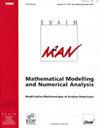具有耗散内含物的声波导
IF 1.9
3区 数学
Q2 Mathematics
Esaim-Mathematical Modelling and Numerical Analysis-Modelisation Mathematique et Analyse Numerique
Pub Date : 2022-07-01
DOI:10.1051/m2an/2023070
引用次数: 0
摘要
我们考虑声波在含有可穿透的耗散包体的波导中的传播。我们证明了只要耗散不为零,散射解是唯一定义的。此外,我们给出了η→0 +(小耗散)和η→+∞(大耗散)时对应的散射矩阵的渐近展开式。令人惊讶的是,在η→+∞极限处,我们发现包体没有能量被吸收。这是由于所谓的皮肤效应现象,并可以解释的事实,即场不再穿透到高耗散包涵体。这些结果保证了在单模状态下,反射系数的振幅相对于η具有全局最小值。这个最小值为零的情况,即当器件作为一个完美的吸收器时,在某些应用中特别有趣。然而,这种情况通常不会发生。在这项工作中,我们展示了如何扰动波导的几何形状以在单模状态下创建二维完美吸收器。用误差估计证明了渐近展开式的合理性,并用数值实例支持了理论结果。本文章由计算机程序翻译,如有差异,请以英文原文为准。
Acoustic waveguide with a dissipative inclusion
We consider the propagation of acoustic waves in a waveguide containing a penetrable dissipative inclusion. We prove that as soon as the dissipation, characterized by some coefficient η , is non zero, the scattering solutions are uniquely defined. Additionally, we give an asymptotic expansion of the corresponding scattering matrix when η → 0 + (small dissipation) and when η → +∞ (large dissipation). Surprisingly, at the limit η → +∞, we show that no energy is absorbed by the inclusion. This is due to the so-called skin-effect phenomenon and can be explained by the fact that the field no longer penetrates into the highly dissipative inclusion. These results guarantee that in monomode regime, the amplitude of the reflection coefficient has a global minimum with respect to η . The situation where this minimum is zero, that is when the device acts as a perfect absorber, is particularly interesting for certain applications. However it does not happen in general. In this work, we show how to perturb the geometry of the waveguide to create 2D perfect absorbers in monomode regime. Asymptotic expansions are justified by error estimates and theoretical results are supported by numerical illustrations.
求助全文
通过发布文献求助,成功后即可免费获取论文全文。
去求助
来源期刊

CiteScore
2.70
自引率
5.30%
发文量
27
审稿时长
6-12 weeks
期刊介绍:
M2AN publishes original research papers of high scientific quality in two areas: Mathematical Modelling, and Numerical Analysis. Mathematical Modelling comprises the development and study of a mathematical formulation of a problem. Numerical Analysis comprises the formulation and study of a numerical approximation or solution approach to a mathematically formulated problem.
Papers should be of interest to researchers and practitioners that value both rigorous theoretical analysis and solid evidence of computational relevance.
 求助内容:
求助内容: 应助结果提醒方式:
应助结果提醒方式:


